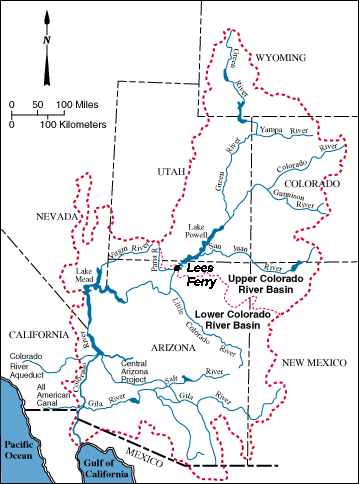The Compact and Lees Ferry
The Colorado River is managed and operated under numerous compacts, federal laws, court decisions and decrees, contracts, and regulatory guidelines collectively known as the "Law of the River." The most important of these is the Colorado River Compact (hereafter, the “Compact”).
In 1922, the Compact was negotiated by the seven Colorado River Basin states and the federal government. It defined the relationship between the upper basin states, where most of the river's water supply originates, and the lower basin states, where the demand for water was growing fastest at the time. One of the main motivations for the Compact was California's interest in plans for Boulder Canyon (Hoover) Dam and other water development projects in the lower basin that could, under the Western water law doctrine of prior appropriation, later deprive upper basin states like Colorado and Utah of their ability to use the river's flows in the future.
The Compact established Lees Ferry, Arizona as the dividing point between the upper basin (Colorado, Wyoming, Utah, and New Mexico) and the lower basin (California, Nevada, and Arizona). The Compact effectively split the flow of the river at Lees Ferry in half, with 7.5 million acre-feet (MAF) per year apportioned to the upper basin, and 7.5 MAF apportioned to the lower basin. The upper basin, being upstream, was given the responsibility of delivering* the lower basin’s allotment. A treaty between the U.S. and Mexico in 1944 further allocated 1.5 MAF per year to Mexico.

In total, the Compact and later treaties apportioned 16.5 MAF per year of the river’s flow at Lees Ferry (though there is contention about whether an additional 1.0 MAF allocated to the lower basin was intended to come from the mainstem or lower basin tributaries--if the former, then the total apportionment at Lees Ferry is 17.5 MAF). The Compact’s negotiators believed that the average flow at Lees Ferry was about 16.4 MAF, based on the 20 years of gage records available in 1922. However, the flow since 1922 has been generally lower than these early gaged flows, and the long-term mean gaged flow at Lees Ferry (1906-2004) is about 15.1 MAF. In other words, the Colorado River has been over-allocated. There is not enough water in the river, on average, to fulfill all of the legal entitlements.
This overallocation has not yet led to major conflicts or forced any curtailments of use, largely because the upper basin has historically used much less than their full share of the river. But the upper basin’s use has been increasing along with population, especially in Colorado. Also, the completion of the Central Arizona Project (CAP) in 1993 brought Arizona's use up to its full allocation. Then, beginning in 2000, a severe and persistent drought has challenged the system more than any previous drought. The combination of higher usage in the upper basin and low natural runoff led to very low inflows into the major reservoirs. Lake Powell dropped to one-third of its capacity, and the threat arose of a Compact-driven curtailment of upper basin uses in order to deliver the lower basin’s full share.
For more information about the Compact and management of the Colorado River, please visit these sites:
- WWA Colorado River Law and Policy resources
- Drought on the Colorado River (PDF): March/April 2005 issue, Southwest Hydrology
- Law of the River web page at U.S Bureau of Reclamation, Lower Colorado Region
*The language of the Compact does not actually use the word "deliver". Instead, it specifies that the upper basin shall "not deplete" the flows of the Colorado below that necessary for 75 MAF in a 10-year period (or an average of 7.5 MAF per year) to pass downstream to the lower basin.



